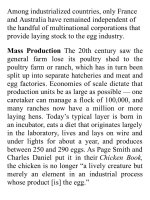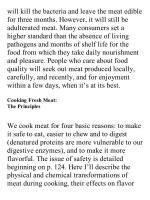On food and cooking the science and lore of the kitchen ( PDFDrive ) 1390
Bạn đang xem bản rút gọn của tài liệu. Xem và tải ngay bản đầy đủ của tài liệu tại đây (157.64 KB, 2 trang )
Clove
wines
guaiacol
Barrel-agedred
Ethyl,vinyl
Tobacco
wines
guaiacol
Earthiness:
Botrytized
Octenol
Mushrooms
wines
CabernetSauvignon,
Sulfur
Stone
SauvignonBlanc
compound
Smoke, Manyred
Ethylphenol,ethyl
Tar
wines
guaiacol,vinylguaiacol
Sweet,caramel:Maple
Sherry,
Sotolon
syrup,fenugreek
port
Butter Manywhitewines Diacetyl
Roasted:Coffee,
Sulfur
Champagne
toastedbrioche
compounds
Grilled
Sauvignon
Sulfur
meats
Blanc
compounds
Animals:
Many
Leather,horse, red
stable
wines
Ethylphenol,ethyl
guaiacol,vinyl
guaiacol
Cat SauvignonBlanc Sulfurcompounds
Solvent:
TDN
Riesling
Kerosene
(trimethyldihydronaphthalene
Nailpolish
Many
Ethyl
remover
wines
acetate
TasteThetasteofawineismostlyamatterof
its sourness, or a balance between sour and
sweet, and a savory quality that has been
attributed to succinic acid and other products
ofyeastmetabolism.Phenoliccompoundscan
sometimes contribute a slight bitterness. The
acid content of a wine is important in
preventing it from tasting bland or flat; it’s
sometimessaidtoprovidethe“backbone”for
the wine’s overall flavor. White wines are
usually around 0.85% acid, red wines 0.55%.
Winesthatarefermenteddry,withnoresidual
sugar,maystillhaveaslightsweetnessthanks
to the alcohol and glycerol, a sugar-like
moleculeproducedbytheyeasts.Fructoseand
glucosearethepredominantsugarsingrapes,









